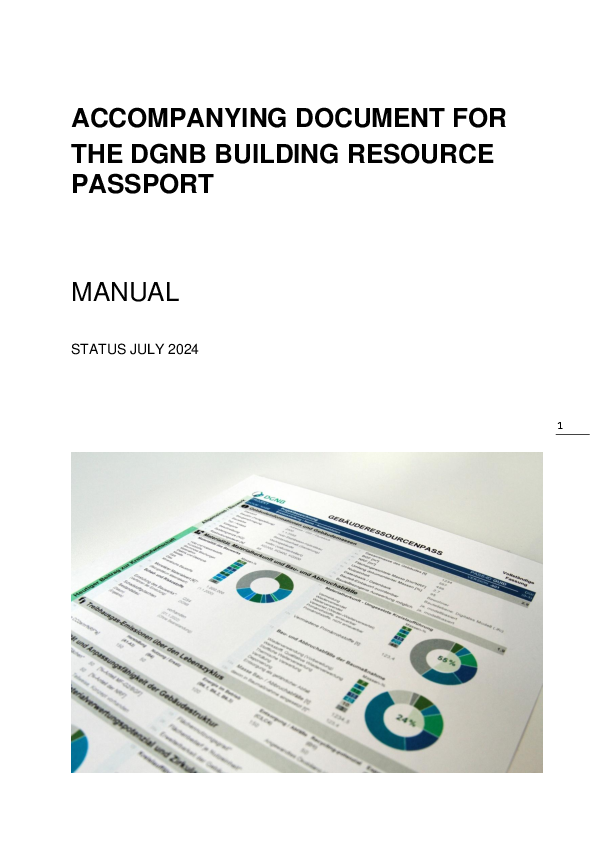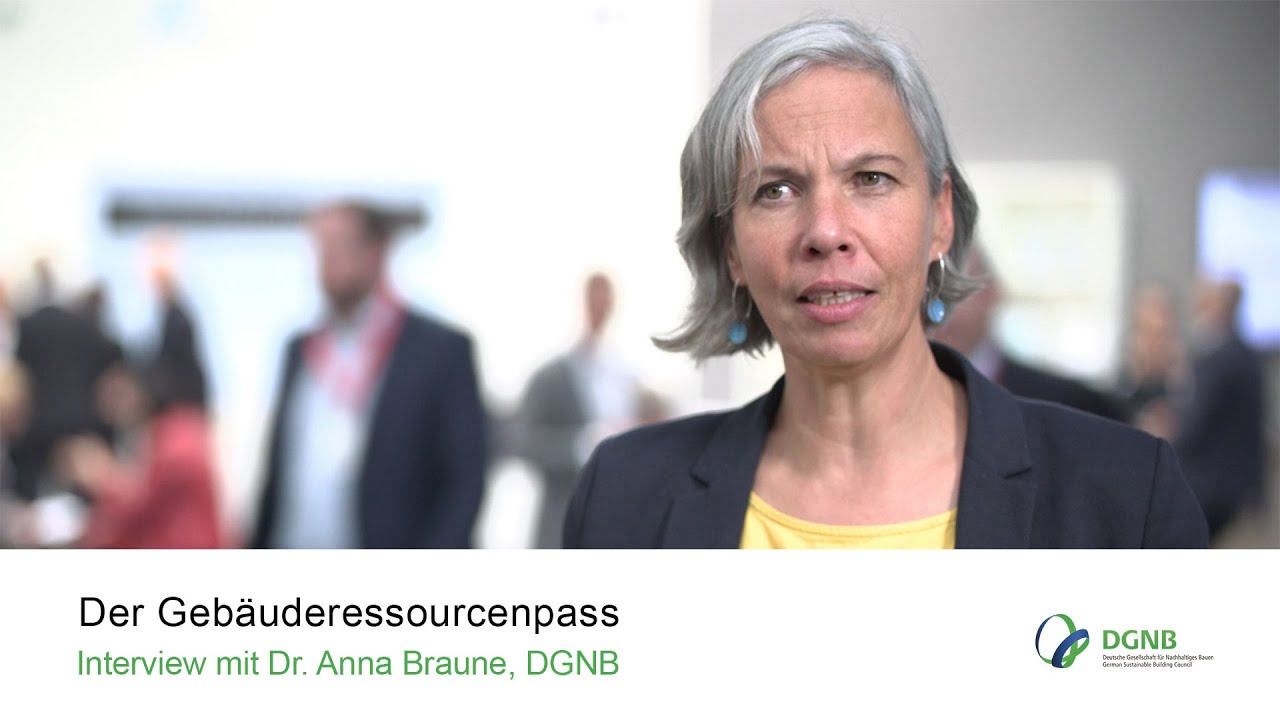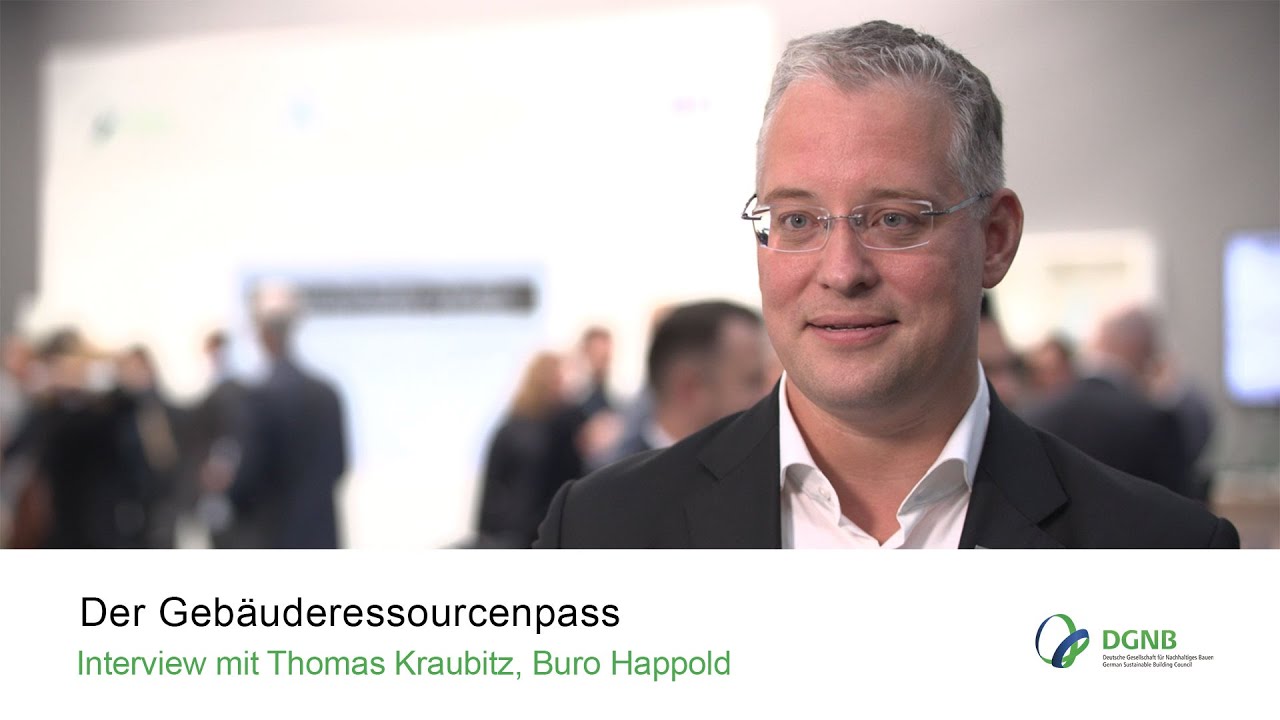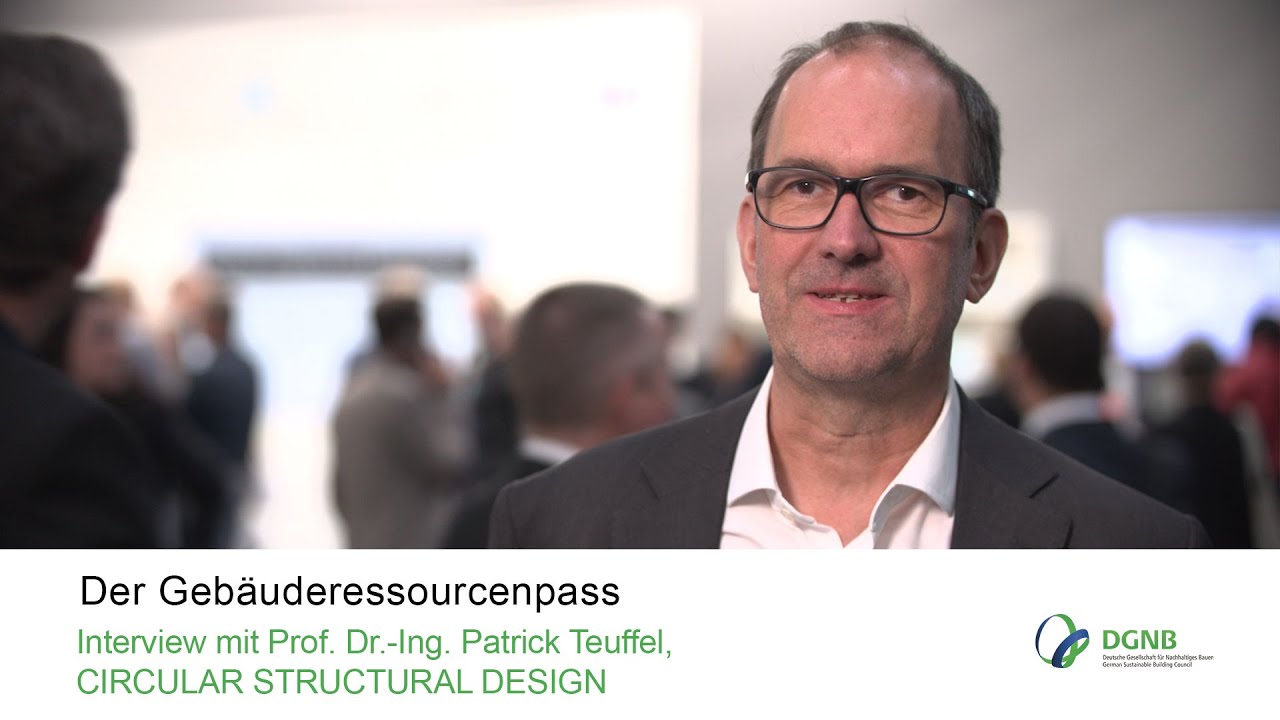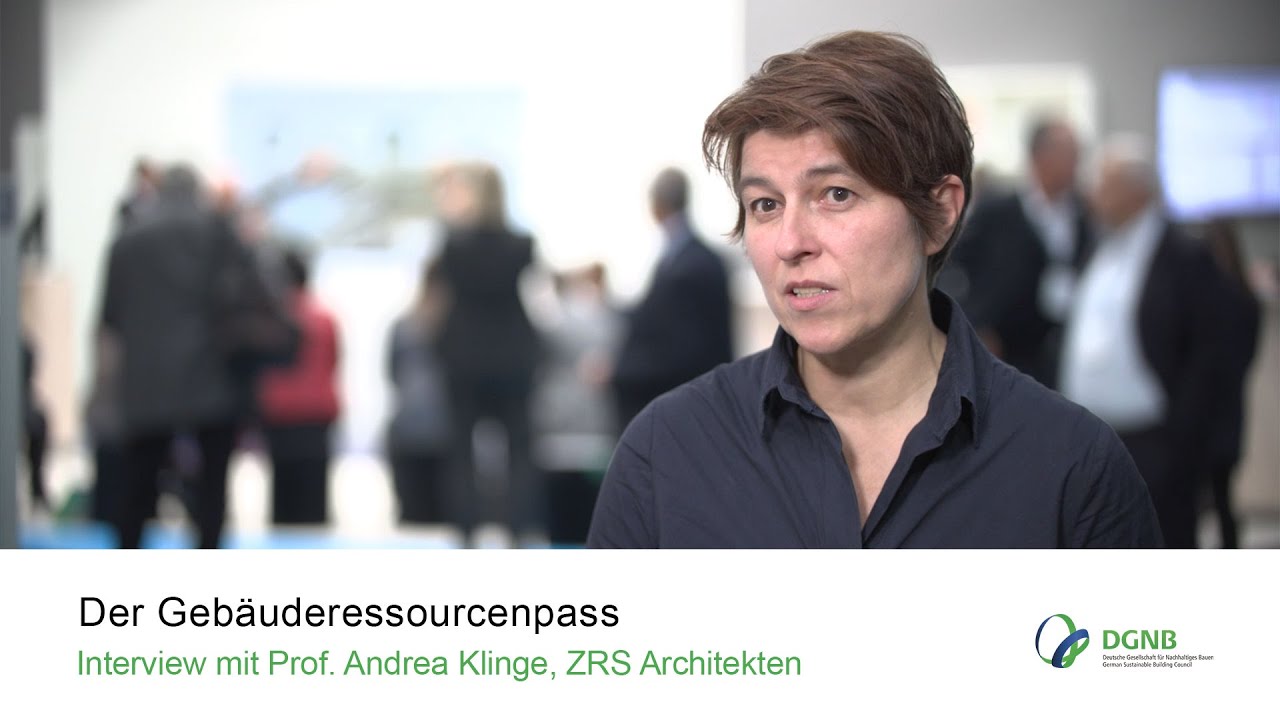Circular building aims to create buildings that are optimised over their entire life cycle. In terms of materials, the aim is to use resources that are already available, to reduce mass and thus minimise environmental impact. A sound information base is needed to assess whether buildings are already contributing to the circular economy, how long they can be used and adapted, and whether they can be dismantled, separated and reused in the future, i.e. whether they are recyclable.
This is where the DGNBs Building Resource Passport comes in. As a documentation format, it creates an information base for all phases of a building's life cycle, thus making an important contribution to transparency regarding materials used, the greenhouse gas emissions of buildings and their circularity. It can also be linked to existing tools. The DGNB Building Resource Passport can be seen as a documentation template, and although is not yet universally recognised, using the DGNB Building Resource Passport is encouraged when certifying a project according to the 2023 version of the DGNB System for New Construction of Buildings, as it simplifies the assessment process by capturing the quality of data and how it is gathered.
Key information at a glance
The basic concept of the Building Resource Passport is based on the idea of the successfully established Energy Performance Certificate. The idea is that the resource passport should contain essential information on resource use, climate impact and circularity for each individual building.
This should provide all of the best possible information required to support the development of 'urban mines', the implementation of circular renovation and new construction, and circular and selective deconstruction.
In the long term, the Building Resource Passport establishes a foundation for a systematic circular economy in the building sector, in which all life cycle phases – from planning to reuse or recycling – are perfectly coordinated and interconnected. This requires full transparency regarding materials and components used, their value and ownership. It is the foundation for a new shared economy, new business models and a built environment of high quality.
Collecting data for a building resource passport can also serve as a basis for an aggregated circularity assessment of buildings.
Owners of new or existing buildings receive information on materials actually used and any harmful substances. They also receive information on the potential of materials and their value. For planners, the tool offers added value, especially when the optional supplementary sheets (see below) for the Building Resource Passport are used. These make it possible to conduct in-depth assessments, to provide clients with professional advice, and to develop circular options that help save resources.
Building contractors can use this format to systematically document any measures they have implemented and provide a clear overview of services provided. Local authorities can also benefit from the use of project-specific building resource passports. For example, they can be used as a basis for establishing and managing urban mines. In the future, this format could also form the basis for approving resource-optimised circular buildings.
The Building Resource Passport can be used for both new and existing buildings. It is designed as a template for users to enter data. The template is based on a catalogue of building components, exports of BIM models or building categories according to corresponding tools.
Detailed instructions on how to use the templates, with a full description of all topics covered, will follow shortly.
Some providers of digital tools used to document or optimise buildings, such as Concular, Madaster, the Circularity Design Toolkit from EPEA or the Urban Mining Index, have already implemented or are planning to implement the requirements of the DGNB Building Resource Passport. Compatibility with federal and EU measures, such as the planned digital resource passport for buildings, is also ensured.
Detailed information on the DGNB Building Resource Passport can be found below.
Depending on how much information is available on a building, the building resource passport comes in two versions: a complete version and a reduced version for beginners. The following tool can be used to generate relevant aggregated information and values for building resources - in both the reduced and the full version.


Example of a DGNB Building Resource Passport template (new building)

Example of a DGNB Building Resource Passport template (existing building)
To illustrate application, you will find application examples based on hypothetical projects (new/existing buildings) below. We also provide an example of the optional calculation of the circularity index and an overview of relevant metrics on a material level. Below you will also find examples of seven optional supplementary sheets, which can be used to carry out more in-depth assessments.
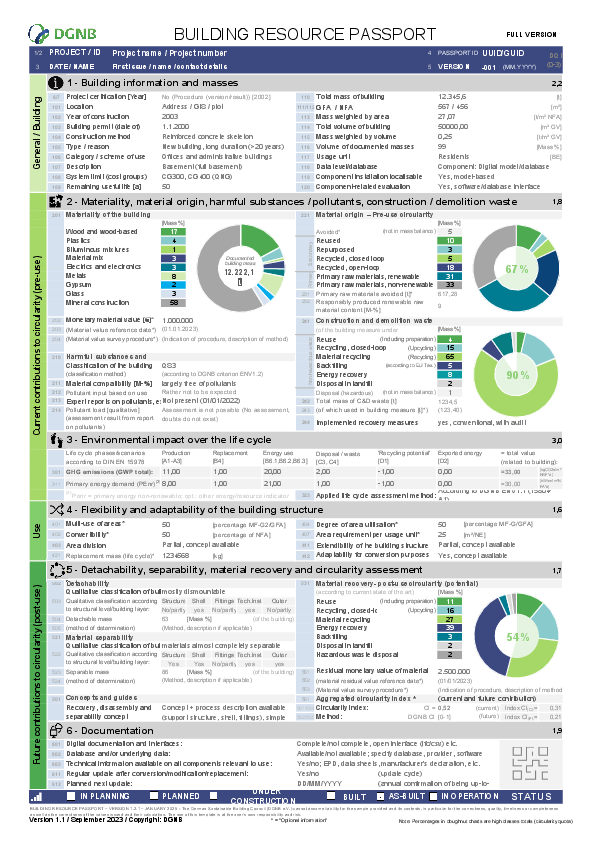
DGNB Building Resource Passport | Example: new building, full version
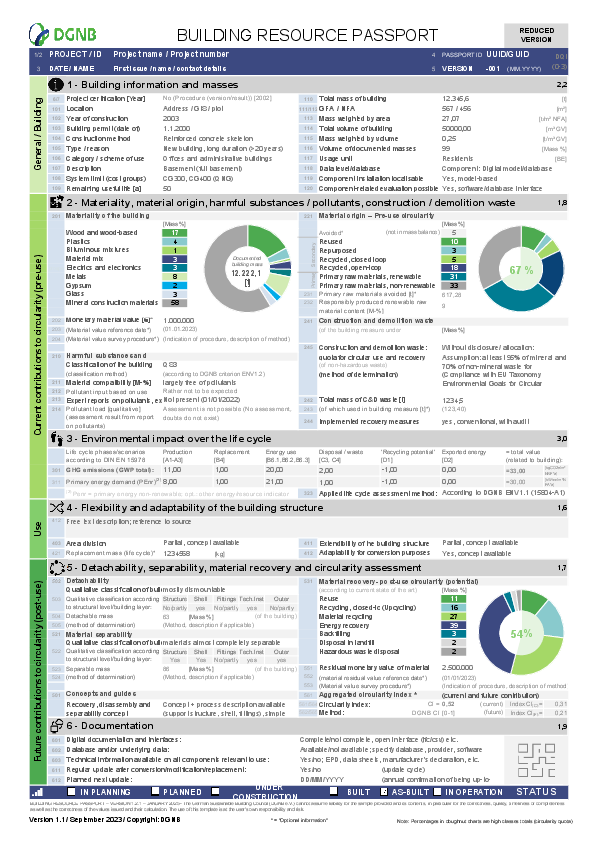
DGNB Building Resource Passport | Example: new building, reduced version
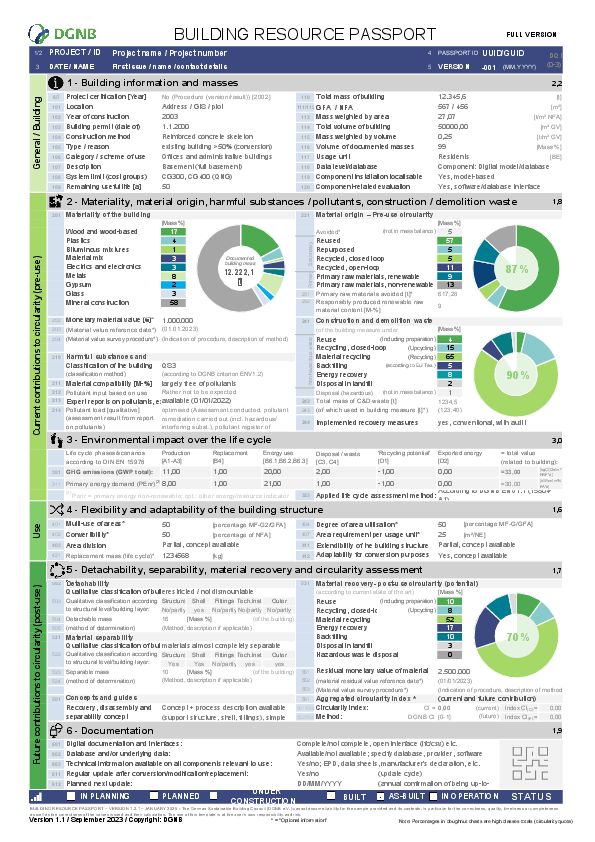
DGNB Building Resource Passport | Example: existing building, full version
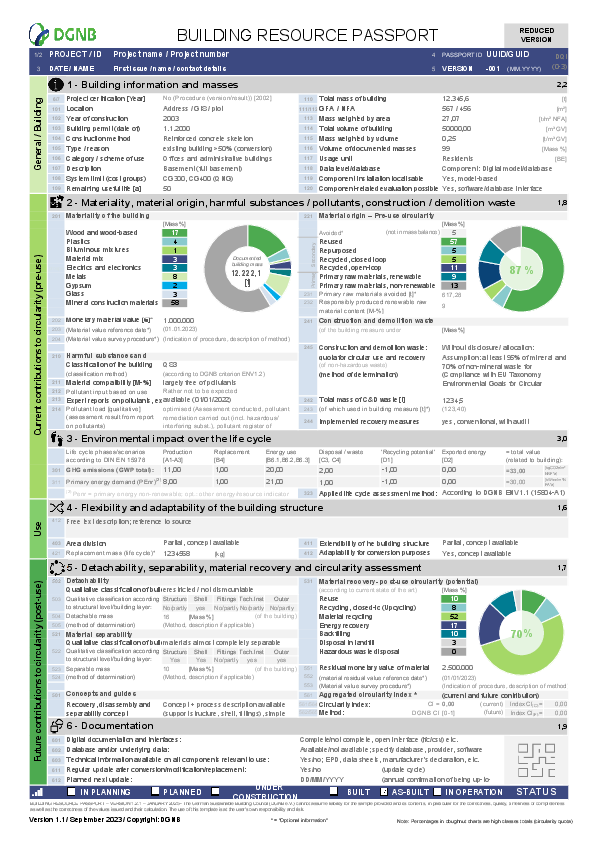
DGNB Building Resource Passport | Example: existing building, reduced version
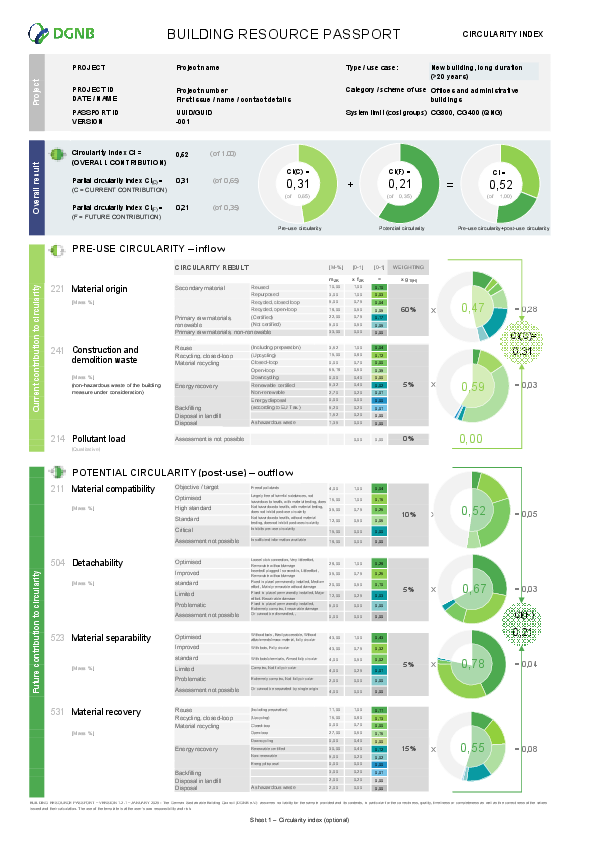
DGNB Building Resource Passport | Example: Optional output of the circularity index for a use case involving a new building (long-lasting)

Optional supplementary sheets for the DGNB Building Resource Passport | Example: new building
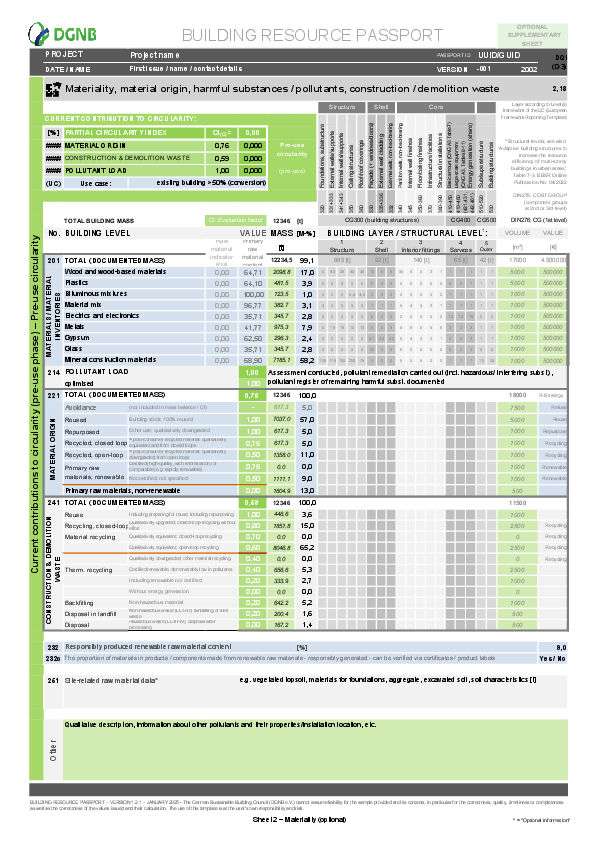
Optional supplementary sheets for the DGNB Building Resource Passport | Example: existing building

Overview of relevant product key figures for the DGNB Building Resource Passport
The Building Resource Passport in detail
With regard to content, the Building Resource Passport comprises six overarching categories with a total of 13 sub-factors or 98 individual input values, which are either mandatory ('mandatory information') or optional ('optional information'):
General information
In order to assess the quality and reliability of data provided, the quality of relevant individual inputs in the Building Resource Passport is assessed. This is then output as a number from 0 to 3 per area in the form of a data quality Index. Based on numbers or scores, this index categorises the quality of data with respect to the method used to collect data: 0 = no information/not reliable, 1 = estimated/imprecise (e.g. statistical values), 2 = measured/calculated (e.g. on the basis of an extended building component catalogue) and 3 = database/model. The methodologies themselves are categorised according to how independently data was determined: 0 = self-created, 1 = data checked internally, 2 = data checked externally and 3 = data checked independently externally.
Section: Building information and building masses
Site and year of construction | Method of construction | Type/occasion: preservation of existing buildings or new construction
In addition to the site and year of construction, the basic information in a Building Resource Passport also includes the construction methods and classification into existing or new buildings. This information is crucial for resource use and conservation. Among other things, building methods can influence the lifespan of a building as well as the availability of materials and components for later reuse. The decision to preserve existing buildings is unavoidable given the scarcity of resources in the construction sector, which is why it is highlighted in the Building Resource Passport.
Remaining useful life
The remaining useful life of a building is the difference between the total useful life and the age of a building.
Total mass of a building
Circular aspects regarding how resources are used for a building can be represented using mass-based quotas. To determine such quotas, the total mass of a building must be known. Ideally, individual masses are allocated to each building component according to cost groups (according to DIN 276). Based on this, further evaluations can be conducted or designed.
Total building mass, weighted by area
The total mass weighted by area puts the total mass of a building in relation to its existing area, thus making a comparison with other buildings possible.
Volume of documented masses
In order to achieve comparability and conduct an adequate assessment of the meaningfulness and quality of circularity information submitted in a Building Resource Passport, it is necessary to indicate the scope of consideration and provide an estimate of the percentage of building mass to which all resource-related information in the Building Resource Passport applies.
Database
Building Resource Passports can and should pull together and categorise information collected from material passports and component catalogues. In order to categorise data quality and establish comparability, a brief qualitative description should be provided of the basis of data in a Building Resource Passport.
Unit of building use
The so-called unit of use (for example ‘occupant’, ‘tenant’ or ‘user’) forms the basis of further, more detailed assessments. For example, this can refer to the flexibility or adaptability of a building (amount of area used).
Section: Materiality, origin of materials, harmful and hazardous substances and construction and demolition waste
The different types of materials used in a building should be specified in mass-based quotas. The material composition of a building affects its recyclability and emissions. Knowing which types of materials are being used forms a basis for optimising subsequent use. The classification of material types is based on European agreements.
The value of all integrated building resources can also be determined as the material value when materials are introduced/installed and, optionally, specified. There is currently no standard procedure for determining material value and the DGNB does not specify a calculation method, which is why it is necessary to provide details of the calculation method used when determining the value of a material. One approach, for example, is to work out the trading, commodity or market value of a material. Examples of different ways to calculate material value are presented by the issuers of building resource passports and the providers of tools such as Madaster or Concular. See: https://docs.madaster.com/files/de/Madaster%20-%20Finanzielles%20Modul.pdf
The mass-weighted shares of recovered, recycled and renewable or non-renewable primary materials used in a building provide information on actual contributions to circularity already made. A more differentiated categorisation and subdivision of shares into reused, recovered (recycled) or renewable raw materials in a building highlights the quality of contributions made and any efforts made to implement circularity today. An indication of any primary materials avoided can also be provided.
In an economy based on circular building and property, materials and components can be returned to the cycle after use and, ideally, they are still useful for people and the environment. If the constituents of building components or materials are already classified as pollutants or harmful substances, or if there is a prospect of them being prohibited, this makes future use or recycling difficult or even impossible. Pollutants and hazardous substances already in use should be isolated in closed loops to prevent them from being recycled.
It is therefore necessary to determine whether harmful substances are present in a building. Further measures can be confirmed through certification and documented in the building resource passport. Verification using common tools – such as the DGNB System (criterion: "Local environmental impact" ENV1.2 or according to DGNB EU Taxonomy Verification) or the BNB System (criterion K1.1.6) – is recommended and this can be captured in the building resource passport. In the case of existing buildings, it is also important to know whether and, if so, when and with what results a pollutant report has been prepared.
Much of the world's waste is generated during the demolition and construction process. Such waste materials should be treated as valuable resources and as much as possible should be undertaken to recover these resources. Both the total amount of construction and demolition waste – as well as recovery routes – should be documented using quotas.
If a previous deconstruction was included in the scope of a project, it should be indicated whether this was selective or non-selective.
Section: Environmental impact over the entire life cycle
In order to assess the climate impact of a building or measures implemented for renovations, transparency is required with regard to greenhouse gas emissions (calculated over the entire life cycle). By presenting and allocating greenhouse gas emissions (and non-renewable primary energy used) in the Building Resource Passport to different life cycle phases, structured according to DIN EN 15978, it is possible to identify the amount of greenhouse gas emissions and energy consumption from production, transport and construction that have already been emitted, plus those that will occur under use and post-use scenarios. Building-related greenhouse gas emissions are an extremely import aspect of the ecological footprint of a building.
Optionally, further environmental impacts over the life cycle or per module can be specified in input values, or they can be added to the optional supplementary sheet (3-Environmental Impacts).
Section: Flexibility and adaptability of the building structure
Adaptability and flexibility allow for intensive use of space and the preservation of a building, even if there are changes in requirements regarding how it is used. The Building Resource Passport can be used to document the extent to which the design of a building allows for multiple usage scenarios or the subdivision of space. In addition, information on the amount of space used and space requirements per reference unit makes it possible to draw comparisons regarding efficiency and the sufficiency of use. Qualitative statements on expandability can help extend the remaining useful life of a building and ensure it is put to intensive use.
Optionally, specifying volume/mass of a material that can be exchanged over the entire life cycle can be used to show how resource-efficient a building is in actual use.
Section: Dismantling capability, separability of materials, material recovery and circularity assessment
The possibility to dismantle and detach materials in a building can be described in quantitative or qualitative terms. The separability of resources and components into different materials can also be described quantitatively in the form of quotas, or it can be captured qualitatively.
To enable the circularity of buildings and their components, end-of-life scenarios need to be considered during the design and planning stages. When designing a building, this means preparing for repair, conversion and deconstruction from the outset, and developing concepts and specific instructions so that resources are available in the future. Different design concepts contributing to circular building can be documented accordingly in a Building Resource Passport by indicating whether appropriate concepts and instructions regarding adaptability, deconstruction and segregation by material type are in place.
Future circularity can be described by showing the possible ‘post-use paths’ of materials and resources used. This information should be provided in a Building Resource Passport based on the current status. Other perspectives can also be considered in the optional supplementary sheet.
The resources required by a building should be classified according to subsequent use, such as reusability or (material) recyclability. If no subsequent use is possible, the method of disposal or any landfilling that is likely to be required should be indicated. On a building level, information should be given in quotas based on masses.
Circularity encompasses a wide range of building and material characteristics. An aggregated overall assessment of circularity is therefore challenging. Overall circularity concerns all life cycle phases of a building: already reusing building components or successfully conserving the building fabric are as important as likely circularity in the future.
A Building Resource Passport can indicate whether an aggregated quantitative circularity assessment has been carried out using a recognised methodology and what the result was. In this way it becomes transparent which methodology has been used to assess circularity and a degree of comparability is possible.
To continuously improve how building circularity is assessed or compared, especially for the sake of higher-level decision-making processes, the DGNB believes in using circularity indices. These are indicators that synthesise the assessment or comparison of building circularity into metrics.
Section: Documentation
Currently, a number of approaches are being tested to document the materials used in a building and their properties. A building resource passport needs to align with current and future planning practices. Overlaps with common digital planning tools are therefore essential. The data on which a Building Resource Passport is based should be readily accessible. Accordingly, it should be available in a digital format and enable different authorised stakeholders to use information throughout the life cycle. For example, building owners, occupants and development and demolition companies can benefit from any transparency created. Renovations and maintenance work should also be recorded to show not only the state of development, but also the actual state of the building.
Development of the Building Resource Passport
The Building Resource Passport was developed in close consultation with the DGNB Committee for Life Cycle and Circular Building, which was set up in 2022. In addition, an open consultation phase was conducted in the summer and autumn of 2022, during which more than 150 suggestions from external stakeholders were received, not only in writing but also in meetings and presentations. This feedback, alignment with tools available on the market, as well as coordination with a draft of the Federal Institute for Research on Building, Urban Affairs and Spatial Development, led to the overhauled version published in February 2023.
In addition, alignments with goals and data structures were made on an overarching level and in terms of specific details. This was in order to achieve a very high level of compatibility with a large number of existing and new initiatives on a national and European level – from political steering affecting the building sector to how data on building materials is organised.
Frequently asked questions
Until now, there has been no standard procedure for determining material value or residual material value, and the DGNB does not provide specifications or information in this regard.
Material value and residual material value are considered optional inputs in the DGNB Building Resource Passport. The following terms/descriptions and methods to determine values can be used:
- Material value = the market value of all materials when they enter into use in a building
- Residual material value = the residual value of material content at the end of its life cycle or after some form of dismantling (market value minus recovery/processing costs – potentially multiplied by a correction factor, or with inflation added)
The providers of different tools or issuers of building resource passports (such as Madaster and Concular) define residual material value as follows:
https://docs.madaster.com/files/de/Madaster%20-%20Finanzielles%20Modul.pdf
Your contact
E-Mail: zirkularitaet@dgnb.de

